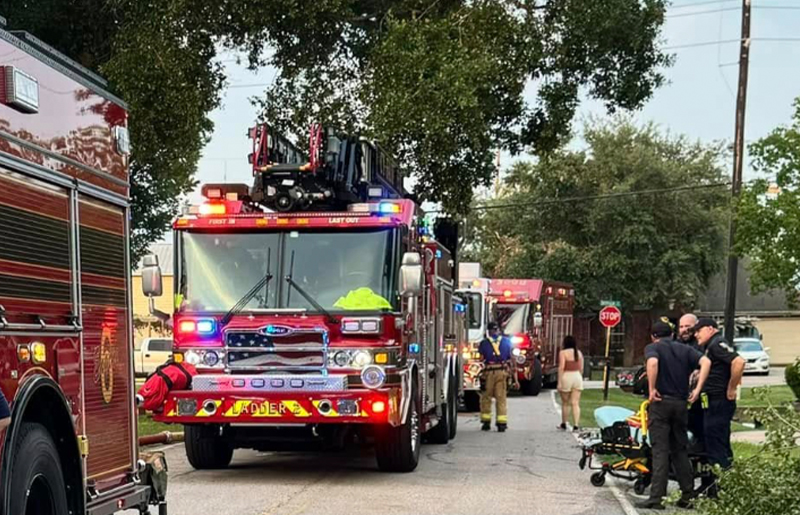
Overhanging Tree Growth in Sheffield Could Delay 911 Help—Here’s What Residents Need to Know
When every second matters, even something as ordinary as a tree branch can make a life-changing difference. In Sheffield, the Cy-Fair Fire Department wants residents to know that low-hanging limbs and parked cars in the road could slow or even block first responders during an emergency.
It’s not a warning meant to alarm—it’s a reminder born out of care for the neighborhood.
Summer in Sheffield means mature trees are in full bloom, providing comfort, character, and welcome shade. But those same branches—especially older, heavier ones that stretch over driveways and streets—can become obstacles for fire engines, ambulances, and high-water rescue vehicles trying to reach a home in crisis.
“It’s easy to overlook when your street looks peaceful,” said Leah Gowin, Public Information Officer for Cy-Fair Fire Department. “But when we’re responding to a fire or a medical emergency, one blocked road or low limb can keep us from getting there in time.”
Why Overhanging Tree Branches Matter
Many residents may not realize that emergency vehicles—especially fire trucks—require significantly more clearance than passenger cars. Large equipment like ladder trucks and high-water rescue units can exceed 12 feet in height and need vertical clearance of at least 14 feet to safely pass without risk of hitting tree limbs, gutters, or low-hanging lines.
Typical Emergency Vehicle Dimensions:
- Fire Engines: Approximately 10 feet tall, 9 feet wide, 35 feet long
- Ladder Trucks: Up to 12 feet tall, 45–50 feet long
- Ambulances: Approximately 9 feet tall, 8 feet wide, 22–25 feet long
- High-Water Rescue Trucks: Often exceed 12 feet tall
If a branch is hanging too low or a tree has grown out into the roadway, these vehicles may have to stop or reroute. That’s valuable time lost in situations where minutes—or even seconds—are critical.
“We’ve had trucks sustain damage or be forced to find alternate routes because of overgrowth,” Gowin explained. “And in an emergency, that’s time we just don’t have.”
Mobile Sidebar Ad
Street Parking Can Also Cause Delays
It’s not just trees. Parking on the street—especially on both sides—can create a bottleneck that prevents emergency vehicles from getting through at all.
Many roads in Sheffield, particularly those with curves, cul-de-sacs, or older layouts, are too narrow for large emergency equipment to safely pass when vehicles are parked on both sides.
Fire engines and ambulances need at least 20 feet of clear road width to operate safely. Even temporarily parked vehicles can block the path or cause first responders to reverse or take longer detours, which could delay care or firefighting efforts.
“We understand people need to park close to home,” Gowin noted, “but being mindful of how it affects emergency access is a small action that can make a huge difference.”
What Residents Can Do—Today
For Sheffield homeowners and renters, these small maintenance steps and parking habits can help protect your neighbors and your own household:
- Trim trees to allow at least 14 feet of vertical clearance over streets and driveways
- Keep limbs and foliage cut back from curbs, fire hydrants, and street corners
- Avoid parking on narrow roads, curves, or across from other parked cars
- Report damaged or dangerously low public trees to HOA or county services
By staying proactive, residents can make Sheffield a safer and more accessible community—especially in those moments when first responders need to get through fast.
“Tree trimming might not seem like an emergency,” Gowin added, “but when it’s done ahead of time, it helps us save lives.”
For more community safety updates and neighborhood-friendly tips, stay connected with My Neighborhood News—your trusted local source for Sheffield.
 Tiffany Krenek has been on the My Neighborhood News team since August 2021. She is passionate about curating and sharing content that enriches the lives of our readers in a personal, meaningful way. A loving mother and wife, Tiffany and her family live in the West Houston/Cypress region.
Tiffany Krenek has been on the My Neighborhood News team since August 2021. She is passionate about curating and sharing content that enriches the lives of our readers in a personal, meaningful way. A loving mother and wife, Tiffany and her family live in the West Houston/Cypress region.







